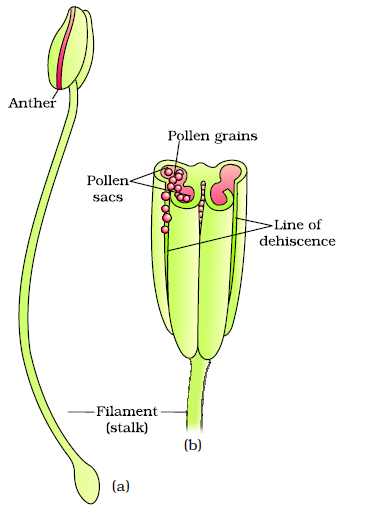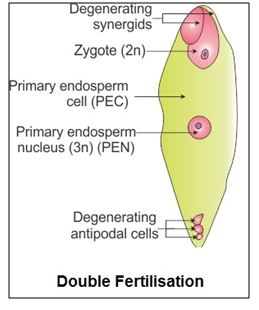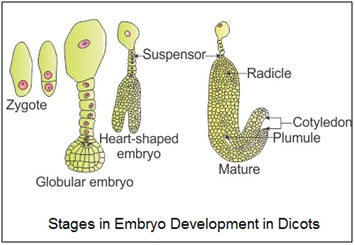SEXUAL REPRODUCTION IN FLOWERING PLANTS
Ø Stamen/Androecium: (male part) – long
slendered stalk (Filament) attached to thalamus & terminal bilobed
structure ANTHER (Bilobed; each lobe Dithecous). Two
Microsporangia present in each lobe (total 4 Pollen sacs).
 |
| (a) A Stamen (b) Section of Anther showing lobes & Microsporangia |
Ø STRUCTURE OF MICROSPORANGIUM: central mass of SPOROGENOUS TISSUE is surrounded by four layers (EPIDERMIS, ENDOTHECIUM,
MIDDLE LAYER and TAPETUM) outer three protective while Tapetum (multinucleated with
dense cytoplasm) nourishes (Food) the developing pollen grains/sporogenous
tissue.
 |
| (a) Section of Anther showing Microsporangia (b) Section of a Microsporangium |
Ø MICROSPOROGENESIS (PROCESS OF FORMATION OF POLLEN
GRAIN FROM Pollen Mother Cell):
Each sporogenous tissue acts as Pollen Mother
Cell (PMC) or Microspore Mother Cell (mmc). Through Meiosis Pollen Tetrad is
formed. As anther mature and dehydrate, pollen grains mature and are released
with dehiscence of anther.
 |
| (Microsporigenesis up to Pollination) |
Ø POLLEN GRAIN (MALE GAMETOPHYTE):
Spherical structures made of outer EXINE (thick, warty & made of SPOROPOLLENIN-one of the most resistant organic
materials known/ no enzyme can degrade it) and inner INTINE (made of cellulose & pectin) &
plasma membrane surrounding the protoplasm. Mature pollen grain contains two
cells (a)
VEGETATIVE CELL: bigger, with abundant food reserve & large irregularly
shaped nucleus. (b) Small GENERATIVE CELL- with spindle shaped nucleus and
dense cytoplasm, floats in the cytoplasm of Vegetative cell.

(Electron Microscopic view of pollen grains of some ferns)
Ø In Over 60% angiosperms pollen grains
are shed at 2 – Cell stage, in others Generative cell again
divides to produce Two male Gametes (3-
Cell Stage) before
dispersal.
 |
| (Stages of Development of Male Gametophyte) |
Ø Pollen Allergy leading to severe
respiratory disorders (Asthma, Bronchitis) eg.. Parthenium (carrot Grass) imported with Wheat has became an
important weed in India causing pollen allergy. Pollen Grains as rich nutrient
& protein Supplements for athletes & race horses. Pollen Banks store
varieties of pollen grains in liquid Nitrogen (-1960C).

(CRYOGENIC using liquid nitrogen)
Ø Gynoecium (female part) may contain single
Pistil (Monocarpellary) or more (Multicarpellary). They may be free (Apocarpous)
or Fused (Syncarpous). Each Pistil has Three parts –
(a) STIGMA: serve as landing platform for pollen grains
(b) STYLE: elongated slendered part projecting
Stigma
(c) OVARY: bulging base containing ovarian
cavities/Locules demarked by walls called Placenta, from which arises OVULES (MEGASPORANGIUM).
| (Pistil / Carpel) |
Ø Number of Ovules: ONE (wheat, rice, mango, litchi) or
MANY (papaya, orchids, watermelon, guava).
Ø OVULE (MEGASPORANGIUM): Small structure attached to placenta
by a stalk/Hilum. Each ovule has 1-2 protective INTEGUMENTS covering it except at the tip called
MICROPYLE; opposite side is called CHALAZA (base of ovule). Inside is a mass of
cells/ NUCELLUS with food reserves. Central part
contains EMBRYO SAC / female gametophyte. Most common
Ovule is a typical ANATROPOUS ovule.
 |
| (Anatropous Ovule) |
Ø MEGASPOROGENESIS: (formation of megaspore/Ovule form megaspore mother cells
or MMC) Ovule generally develops a single megaspore mother cell (MMC) in
micropylar region Ovule generally develops a single large
megaspore mother cell (MMC)with dense cytoplasm& a nucleus, in
micropylar region in Nucellus. MMC
divides meiotically to produce four Megaspores. The numbers of functional
megaspore vary: Mono-/ Bisporic Embryo sac.
 |
| (Basic Types of Embryo Sacs) |
Ø EMBRYO SAC (FEMALE GAMETOPHYTE): MOSTLY only one functional Megaspore
(generally basal) develops into Female Gametophyte (Embryo sac)-Monosporic Development. Nucleus of
Functional Megaspore undergo three (free nuclear) mitotic divisions forming 8 –
nucleated cell. Later cell walls formed. A typical Embryo Sac is an 8-nucleated
& 7- celled structure {POLYGONUM TYPE of Embryo Sac}.
 |
| (Female Gametophyte) |
 |
| (Compared) |
Ø POLLINATION (Transfer of a mature pollen grain to a receptive stigma)
(A) Autogamy :- pollination between anther and
stigma of same flower Cleistogamous flowers like Pisum sativum, some like
Oxalis & Commelina produce
two types of flowers –Chasmogamous & Cleistogamous . Cleistogamy is
essentially Autogamy and hence produce Clones with assured set of seeds.
(B) Geitonogamy: - pollination between different
flowers of same plant.
(C) Xenogamy:- pollination between two different plants of
same species.
 |
| (Types of Pollination) |
Ø Agents of Pollination: Abiotic (wind & water) and Biotic (insects, birds, animals, bat etc..)
Agents. Majority of plants use BIOTIC AGENTS. Only few use abiotic agents due
to Uncertainty of Pollination. Hence to increase chances of pollination such
plants produce enormous amount of pollen grain.
 |
| (Pollinating Agents) |
Ø Wind Pollination (ANEMOPHYLLY):- Most common in abiotic types. Pollen
Grains are small, light & non-sticky. Stamen are well exposed & large,
often Feathery. Ovary bear single ovule & flowers packed into
Inflorescence. Eg.. Tassels of Corn Cob are stigma & style of the flower.
(method is most common in Grasses)
Ø Water Pollination (HYDROPHYLLY):- Common in Monocots. Eg..Freshwater plants (Vallisneria & Hydrilla) & marine plants (Zostera)
[[water
Lily & Water Hyacinth pollination by Wind or Insect?]]
Ø Vallisneria:- Female flower reach water surface
by long stalk & male flower/pollen grain released on surface of water. They
reach the stigma by positive Water Current. In Sea Grasses, same happen inside
the water. In most water pollinated plants, pollen grains are protected from
water by mucilaginous coverings.
Ø INSECT POLLINATION (Entomophylly) :- Most common type
of pollination. Bees are the most important Pollinators. Flowers are large, colorful,
fragrant & rich in Nectar. When flowers are small, then clustered as
Inflorescence. In flowers pollinated by Beetles & flies, the flower secrets
foul odors to attract animals. Nectar & pollen grains are usual rewards.
Often floral rewards are in providing safe place to lay Eggs. Eg.. Tallest
flower Amorphophallus (6 ft. high flower).
Similarly, between a species of moth & plant Yucca. Moth deposits
its eggs in the locule of ovary & flower gets pollinated by moth. The larva
of moth comes out of eggs as the seeds develop.
 |
| (Bees are the most important pollinators for Mankind) |
| (Comparison) |
Ø OUTBREEDING DEVICES (Contrivances for Cross
Pollination):- [ continued Self pollination results in Inbreeding Depression
& loss of Genetic Vigour]
(A) Bisexual Flowers: Pollen release
& stigma receptivity is not synchronized (Protandry/Protogyny), Difference
in position of anther & stigma, Self-Incompatibility (genetic mechanism)
(B) Unisexual Flowers on same plant
(may not prevent Geitonogamy) eg. Castor & Maize.
(C) Dioecy:- male & female plants
separate eg. Papaya, prevent both Auto-/ Geitono-gamy.
Ø POLLEN PISTIL INTERACTION: Pollen grains are shed at 2-celled
stage. Pistil recognizes compatible pollen grain and allows the pollen tube to
grow. Other incompatible pollen grains are stopped through chemicals regulated
by a genetic mechanism of Incompatibility. Pollen tube contains two male
gametes & tube nucleus. In ovary pollen tube enter through Micropyle &
enters one of the Synergids with the help of Filiform Apparatus.
Ø ARTIFICIAL HYBRIDIZATION:- Cross pollination by Human beings to
produce superior breeds. Steps are:
(A) EMASCULATION:-removing immature
anther from a bisexual flower to prevent self pollination. Eg. Mechanical
(forceps), Chemical (nitrous oxide), Thermal (Heat/Cold) or Hormonal.
 |
| (Emasculation) |
(B) BAGGING:- covering emasculated
flower with a suitable transparent bag.
 |
| (Bagging) |
(C) TAGGING:- attaching a tag of details to
recognize the events of breeding. For a Unisexual flower , No emasculation is
needed, only Tagging & Bagging is done.
| (Tagging) |
Ø DOUBLE FERTILIZATION: On entering one of the Synergids, either of the male
gamete move towards the egg cell and fuse with its nucleus (Syngamy) to form
ZYGOTE (2n). Other male gamete move towards the central cell (2n) and fuse to
form a Triploid (3n) PEN (Primary Endospermic Nucleus) [TRIPLE FUSION]. Triple fusion & Syngamy together is
referred to as DOUBLE FERTILIZATION. PEN develops into ENDOSPERM, Zygote into
EMBRYO.
 |
Ø ENDOSPERM (3n):- PEC (Primary Endospermic Cell) divides into a Triploid
endospermic tissue filled with reserve food for developing embryo. Free
Nuclear Endosperm (most common):- PEN divides into many nuclei in a single
cell (later becomes CELLULAR ENDOSPERM by developing walls) eg. Coconut Water
later becoming solid White Kernel. Endosperm may be totally consumed by
developing embryo (Non Endospermic eg. Pea, Beans Groundnut,) or may persist in
mature seed (Endospermic eg. Castor & Coconut) & used up during seed
germination.
Ø EMBRYO:- develops at Micropylar end of embryo sac. Most zygote
divides only after some amount of endosperm formation to assure Nutrition.
Early stages of embryo development (EMBRYOGENY) are similar in both Dicots
& Monocots. Zygote form PROEMBRYO which form Globular, Heart shaped and
Mature embryo. A typical Dicot embryo has an EMBRYONIC AXIS & two
COTYLEDONS (fleshy leaves). Axis above cotyledon level is EPICOTYL (covered in
COLEOPTILE) & forms Plumule (Shoot Tip) while below cotyledon level, the
axis is HYPOCOTYL (Covered in COLEORRHIZA) forming RADICLE (Root Tip). Root tip is covered by a sterile layer for
protection (Root Cap). MONOCOT EMBRYO:- Only one Cotyledon. In grass family the
cotyledon is present on lateral side of embryonic axis & called SCUTELLUM.
 |
 |
Ø SEED (fertilized ovule):- [ Seed Coats + Cotyledons +
Embryonic Axis] may be Albuminous &
Non Albuminous. PERISPERM is the remnant persistent Nucellus in some seeds
(beet, Black Pepper).
Ø DORMANCY:- A mature seed has tough & hard seed coats(integuments
of ovule) . Micropyle remains as a small pore in the seed coat through which
oxygen & water enters in it during germination. Seed becomes relatively dry
(10-15 % water by mass) & metabolism slows down, embryo becomes inactive
(DORMANT). It germinates only under favorable conditions (moisture, oxygen,
suitable temperature).
Ø PERICARP:- Wall of ovary develops into the wall of Fruit (PERICARP).
Fruit may be FLESHY (Guava, Orange, Mango) or DRY (groundnut, mustard). Most
fruit develops only from ovary (TRUE eg. Mango); sometimes thalamus or some
other part of flower also contribute to fruit formation (FALSE FRUIT eg. Apple,
strawberry, cashew); in some plants fruit develops without fertilization (no
seeds) they are PARTHENOCARPIC FRUITS eg. Banana.
Ø ADVANTAGES OF SEEDS:-more dependable without water,
dispersal strategies, food reserves, protective coat.
Ø Dehydration & Dormancy of mature
seeds is crucial for storage & subsequent germination. Oldest available
record is that of Lupine (Lupinus arcticus) from arctic Tundra, with a
record of 10,000 years of Dormancy.
Ø Recently 2000 year old seeds of Date
Palm (Phoenix dactylifera) discovered from King Herod’s palace found
viable.
Ø APOMIXIS:- [Production of seeds without fertilization eg. Asteraceae
[Grass family] “A form of asexual
reproduction that mimics sexual reproduction”. Methods to develop apomictic
seeds:
(a) diploid egg (2n) formed without meiosis
develops into embryo without fertilization
(b) Nucellar cells start dividing, protrude
into embryo sac & develop into embryo (2n) eg. Citrus, Mango. Here ovule
contains many embryo (POLYEMBRYONY).
Ø IMPORTANCE OF APOMIXIX IN HYBRID SEED INDUSTRY:- Hybrid Varieties seeds are produced
every year as once sown the characters segregate during progeny formation and
cannot be maintained in subsequent generations. Production of Hybrid variety is
too expensive for farmers. ( if hybrids are made into APOMICTS, no characters
will segregate in progeny).
VIDEOS TO WATCH (Click on the link)
Ovule & Female GametophyteStructure and formation of Embryo Sac
Double Fertilization
Development of Embryo in Angiosperms
(Courtesy Google images and you tube video links)



No comments:
Post a Comment